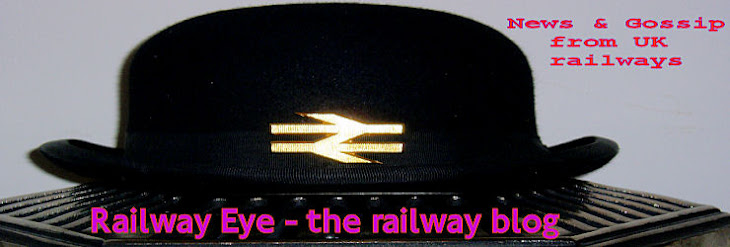Eye posted this last year...
...but it somehow seems more topical now.
Note how, in spite of the white stuff, the railway continues to function.
Younger readers may struggle to recognise an item at the front of one of the kettles in this film.
It is called a snowplough.
Believe it or not they were used to clear the white stuff (snow) from the line so that trains could run normally.
How very quaint!
Eye believes that the last serving railwayman to use one of these in anger was Stewart Palmer.
Stewart, who retired as MD of South West Trains last year, apparently signed snowploughs when he was based at Carlisle.
If readers know of any current railwaymen (or women) who can remember how to use a snowplough please contact Network Rail.
UPDATE: This from NR's Internet Rapid Rebuttal Unit...
Is a snowplough like one of these?
Which was operating in Scotland only last week...
The Fact Compiler responds "And I'd have got away with it, if it hadn't been for that meddling rapid rebuttal unit!"
UPDATE: This from NR's Internet Rapid Rebuttal Unit...
Eye readers may be interested in the hardware that we have available to keep the railway running in winter.
Network Rail’s National Delivery Service (NDS) manage the delivery of NR fleet to the Routes requirements to mitigate the effects of winter weather
19 Multi Purpose Vehicles (MPVs) can be deployed to cover areas with third rail traction to prevent ice build up by spraying an anti-icing agent directly to the conductor rail .
- Kent - 6 based at Tonbridge
- Sussex - 6 based at Horsham
- Wessex - 1 based at Effingham & 4 based at Eastleigh
- LNW (for Merseyrail) - 2 based at Wigan
There is also a hired fleet of locomotives fitted with Miniature Snow Ploughs (MSP) which clear snow up to 450mm above railhead. Some locomotives are also fitted with ‘shoegear’ which also can clear ice / snow from the conductor rail.
In addition, there is a NR fleet of Independent Snow Ploughs (11), Beilhack Ploughs (5) and Snowblowers (2) strategically placed around the network which can be deployed when snow is deeper than 450mm.
This is all in addition to any ‘ghost trains’ (passenger trains without passengers) which may be run by the TOCs, as well as multitude of NR Operations & Customer Service and Maintenance staff out on the patch keeping the lines open.
So now you know.
UPDATE: This just in from a Mr Jacala...
If I remember correctly wasn't Stewart Palmer responsible for scrapping the snow ploughs that were old steam engine tenders and getting the current fleet of purpose built ploughs built?
This, obviously, in his Railtrack days.
UPDATE: This from Mike...
Seems Southeastern are busy trying to cover themselves, but buried in this blogpost on Bexcentric is the following:
"To deal with the effects of snow and ice, once warnings of below zero temperatures are received, Network Rail runs Multi Purpose Vehicle (MPV) trains to lay de-icing fluid and train operators run empty “ghost trains” over night in a bid to keep the tracks clear. However, persistent below zero temperatures coupled with sleet and snow falls of the type we have seen over the last ten days can negate any preventive measures by either washing away the de-icing fluid, or covering the tracks with a fresh coating of snow and ice."
So it seems that those six based at Tonbridge were not much use.
Maybe NR should check if one of the uses of these Multi-purpose vehiches is indeed to de-ice/clear snow?
It's also worth wondering why those "ghost" trains couldn't carry passengers after Southeastern shut the network down at 7pm.
Back to the drawing board, I think.





